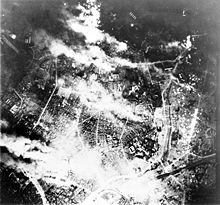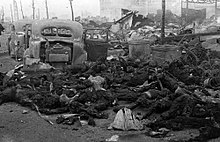User:Wikidgood/hotbox
Conventional bombing

The first U.S. raid on the Japanese main island was the Doolittle Raid of 18 April 1942 when sixteen B-25 Mitchells were launched from the USS Hornet (CV-8) to attack targets including Yokohama and Tokyo and then fly on to airfields in China. The raids were military pin-pricks, but a significant propaganda victory. Launched prematurely, none of the attacking aircraft reached the designated post mission airfields, either crashing or ditching (except for one aircraft, which landed in the Soviet Union, where the crew was interned). Two crews were captured by the Japanese.
The key development for the bombing of Japan was the B-29 Superfortress, which had an operational range of 1,500 miles (2,400 km); almost 90% of the bombs dropped on the home islands of Japan were delivered by this type of bomber (147,000 tons). The first raid by B-29s on Japan from China was on 15 June 1944. The planes took off from Chengdu, over 1,500 miles away. This first raid was also not particularly damaging to Japan. Only forty-seven of the sixty-eight B–29s that took off hit the target area; four aborted with mechanical problems, four crashed, six jettisoned their bombs because of mechanical difficulties, and others bombed secondary targets or targets of opportunity. Only one B–29 was lost to enemy aircraft. The first raid from the east was on 24 November 1944 when 88 aircraft bombed Tokyo. The bombs were dropped from around 30,000 feet (10,000 m) and it is estimated that only around 10% of the bombs hit designated targets.
The initial raids were carried out by the Twentieth Air Force operating out of mainland China in Operation Matterhorn under XX Bomber Command. Initially the Twentieth Air Force was under the command of Hap Arnold, and later Curtis LeMay. This was never a satisfactory arrangement because not only were the Chinese airbases difficult to supply via - materiel being sent over "the Hump" from India, but the B-29s operating from them could only reach Japan if they traded some of their bomb load for extra fuel in tanks in the bomb-bays. When Admiral Chester Nimitz's island-hopping campaign captured islands close enough to Japan to be within the range of B-29s, the Twentieth Air Force was assigned to XXI Bomber Command which organized a much more effective bombing campaign of the Japanese home islands. Based in the Marianas (Guam and Tinian in particular) the B-29s were now able to carry their full bomb loads and were supplied by cargo ships and tankers.

Unlike all other forces in theater, the USAAF Bomber Commands did not report to the commanders of the theaters but directly to the Joint Chiefs of Staff. In March 1945, they were placed under the U.S. Strategic Air Forces in the Pacific which was commanded by General Carl Spaatz.
As in Europe, the United States Army Air Forces (USAAF) tried daylight precision bombing. However, it proved to be impossible due to the weather around Japan, as bombs dropped from a great height were tossed about by high winds. General LeMay, commander of XXI Bomber Command, instead switched to mass firebombing night attacks from altitudes of around 7,000 feet (2,100 m) on the major conurbations of Tokyo, Nagoya, Osaka, and Kobe. Despite limited early success, particularly against Nagoya, LeMay was determined to use such bombing tactics against the vulnerable Japanese cities. Attacks on strategic targets also continued in lower-level daylight raids.
The first successful firebombing raid was on Kobe on 3 February 1945, and following its relative success the USAAF continued the tactic. Nearly half of the principal factories of the city were damaged, and production was reduced by more than half at one of the port's two shipyards.
Much of the armor and defensive weaponry of the bombers was removed to allow increased bomb loads; Japanese air defense in terms of night-fighters and anti-aircraft guns was so feeble it was hardly a risk. The first raid of this type on Tokyo was on the night of 23–24 February when 174 B-29s destroyed around one square mile (3 km²) of the city. Following on that success, as Operation Meetinghouse, 334 B-29s raided on the night of 9–10 March, dropping around 1,700 tons of bombs. Around 16 square miles (41 km²) of the city was destroyed and over 100,000 people are estimated to have died in the fire storm. The destruction and damage was at its worst in the city sections east of the Imperial Palace. It was the most destructive conventional raid, and the deadliest single bombing raid of any kind in terms of lives lost, in all of military aviation history. The city was made primarily of wood and paper, and Japanese firefighting methods were not up to the challenge. The fires burned out of control, boiling canal water and causing entire blocks of buildings to spontaneously combust from the heat. The effects of the Tokyo firebombing proved the fears expressed by Admiral Yamamoto in 1939: "Japanese cities, being made of wood and paper, would burn very easily. The Army talks big, but if war came and there were large-scale air raids, there's no telling what would happen."[1]
In the following two weeks, there were almost 1,600 further sorties against the four cities, destroying 31 square miles (80 km²) in total at a cost of 22 aircraft. By June, over forty percent of the urban area of Japan's largest six cities (Tokyo, Nagoya, Kobe, Osaka, Yokohama, and Kawasaki) was devastated. LeMay's fleet of nearly 600 bombers destroyed tens of smaller cities and manufacturing centers in the following weeks and months.
Leaflets were dropped over cities before they were bombed, warning the people and urging them to escape the city. Though many, even within the Air Force, viewed this as a form of psychological warfare, a significant element in the decision to produce and drop them was the desire to assuage American anxieties about the extent of the destruction created by this new war tactic. Warning leaflets were also dropped on cities that were not to be bombed to create uncertainty and absenteeism.

A year after the war, the United States Army Air Forces's Strategic Bombing Survey (Pacific War) reported that they had underestimated the power of strategic bombing combined with naval blockade and previous military defeats to bring Japan to unconditional surrender without invasion. By July 1945, only a fraction of the planned strategic bombing force had been deployed yet there were few targets left worth the effort. In hindsight, it would have been more effective to use land-based and carrier-based air power to strike against merchant shipping and begin aerial mining at a much earlier date so as to link up with the effective Allied submarine anti-shipping campaign and completely isolate the island nation. This would have accelerated the strangulation of Japan and ended the war sooner.[2] A postwar Naval Ordnance Laboratory survey agreed, finding that naval mines dropped by B-29s had accounted for 60% of all Japanese shipping losses in the last six months of the war.[3] In October 1945, Prince Fumimaro Konoe said that the sinking of Japanese vessels by U.S. aircraft combined with the B-29 aerial mining campaign were just as effective as B-29 attacks on industry alone,[4] though he admitted that "the thing that brought about the determination to make peace was the prolonged bombing by the B-29s." Prime Minister Baron Kantarō Suzuki reported to U.S. military authorities that it "seemed to me unavoidable that in the long run Japan would be almost destroyed by air attack so that merely on the basis of the B-29s alone I was convinced that Japan should sue for peace."
- ^ Spector, Ronald (1985). "Eagle Against the Sun." New York: Vintage Books. p. 503.
- ^ United States Strategic Bombing Survey, Summary Report (Pacific War). 1 July 1946
- ^ Hallion, Dr. Richard P. Decisive Air Power Prior to 1950 Air Force History and Museums Program.
- ^ Major John S. Chilstrom, School of Advanced Airpower Studies. Mines Away! The Significance of U.S. Army Air Forces Minelaying in World War II. Diane Publishing, 1992.
